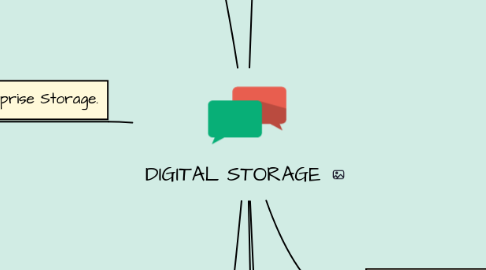
1. Other types of storage.
1.1. A magnetic stripe card has a magnetic stripe that contains information.
1.2. A smart card stores data on an integrated circuit embedded in the card.
1.3. The RFID tag consists of an antenna and a memory chip that contains the information to be transmitted via radio waves.
1.3.1. An RFID reader reads the radio signal and transfers the information to a computer or computing device.
1.4. An NFC-enabled device contains an NFC chip.
1.4.1. An NFC tag contains a chip and an antenna that contains information to be transmitted.
1.4.2. Most NFC tags are self-adhessive.
2. Enterprise Storage.
2.1. Enterprise hardware allows large organizations to manage and store data and information using devices intended for heavy use, maximum efficiency and maximum availability which is RAID duplicates data, instructions and information to improve data reliability.
2.2. Network attached storage (NAS) is a server that is placed on a network with the sole purpose of providing storage to users, computers and devices attached to the network.
2.3. An example of how network attached storage connects on a network:
2.3.1. Client.
2.3.2. Server.
2.3.3. Network attached storage.
2.4. A storage area network (SAN) is a high-speed network with the sole purpose of providing storage to other attached servers.
2.4.1. Tape is a magnetically coated ribbon of plastic capable of storing large amounts of data and information.
2.4.2. A tape drive reads and writes data and information on a magnetic tape.
3. Optical Discs.
3.1. An optical disc consists of a flat, round, portable disc made of metal, plastic and lacquer that is written and read by a laser.
3.2. Optical discs commonly store items in a single track that spirals from the center of the disc to the edge of the disc.
3.3. Track is divided into evenly sized sectors.
3.4. Type of optical discs:
3.4.1. A CD-ROM can be read from but not written to because it is a single-session disc.
3.4.2. A CD-R is an optical disc on which users can write once but not erase.
3.4.3. A CD-RW is an erasable multisession disc.
3.4.4. A DVD-ROM is a high-capacity optical disc on which users can read but not write on or erase.
3.4.5. A DVD-R or DVD+R are competing DVD-recordable WORM formats, on which users can write once but not erase.
3.4.6. DVD-RW, DVD+RW and DVD+RAM are competing DVD-rewritable formats that users can write on multiple times.
4. STORAGE
4.1. A storage medium is the physical material on which a computer keeps data, information, programs and applications.
4.2. Cloud storage keeps information on serves on the internet and the actual media on which the files are stored are transparent to the user.
4.3. A storage device is the hardware that records and/or retrieves items to and from storage media.
4.3.1. Reading is the process of transferring items from a storage medium into memory.
4.3.2. Writing is the process of transferring items from memory to a storage medium.
4.4. Capacity is the number of bytes a storage medium can hold. Terms used to define storage:
4.4.1. Kilobyte (KB) = 1 thousand byte.
4.4.2. Megabyte (MB) = 1 million byte.
4.4.3. Gigabyte (GB) = 1 billion byte.
4.4.4. Terabyte (TB) = 1 trillion byte.
4.4.5. Petabyte (PB) = 1 quadrillion byte.
4.4.6. Exabyte (EB) = 1 quintillion byte.
4.4.7. Zettabyte (ZB) = 1 sextillion byte.
4.4.8. Yottabyte (YB) = 1 septillion byte.
4.5. Types of storage:
4.5.1. An illustration Volatility.
4.5.2. Screen display Volatile.
4.5.3. Contents of most RAM Volatile.
4.5.4. Contents of storage Non-volatile.
4.6. Access time measures:
4.6.1. The amount of time it takes a storage device to locate an item on a storage medium.
4.6.2. The time required to deliver an item from memory to the processor.
5. Hard Drives
5.1. The storage capacity of hard disks varies and is determined by:
5.1.1. The number of platters the hard disks contains.
5.1.2. The composition of the magnetic coating on the platters.
5.1.3. Whether the disk uses longitudinal or perpendicular recording.
5.1.4. Density.
5.2. Formatting is the process of dividing the disk into tracks and sectors. In addition, a head crush occurs when a read/write head touches the surface of a platter so that we need to keep a backup of the hard disk, always.
5.3. Characteristics of a hard disk include:
5.3.1. Tracks.
5.3.2. Sectors.
5.3.3. Platters.
5.3.4. Form factor.
5.3.5. Read/write head.
5.3.6. Revolutions per minute.
5.4. An solid state drive (SSD) is a flash memory storage device that contains it's own processor to manage it's storage. An SSD has several advantages over traditional (magnetic) hard dsiks:
5.4.1. Faster access times.
5.4.2. Faster transfer rates.
5.4.3. Quieter operation.
5.4.4. More durable.
5.4.5. Lighter weight.
5.4.6. Less power consumption.
5.4.7. Less heat generation.
5.4.8. Longer life.
5.4.9. Defragmentation not required.
5.5. An external hard drive is a separate freestanding storage device that connects with a cable to a USB port on a computer or mobile device.
5.6. Redundant array of independent disks (RAID) is a group of two or more integrated hard drives.
6. Portable Flash Memory Storage.
6.1. A memory card is a removable flash memory storage device that you insert and remove from a slot in a computer, mobile device or card reader/writer. Examples:
6.1.1. SDHC.
6.1.2. M2.
6.1.3. SDXC.
6.1.4. Memory Stick PRO Duo.
6.1.5. miniSD.
6.1.6. xD Picture Card.
6.1.7. microSDHC.
6.1.8. CF.
6.1.9. microSDXC.

